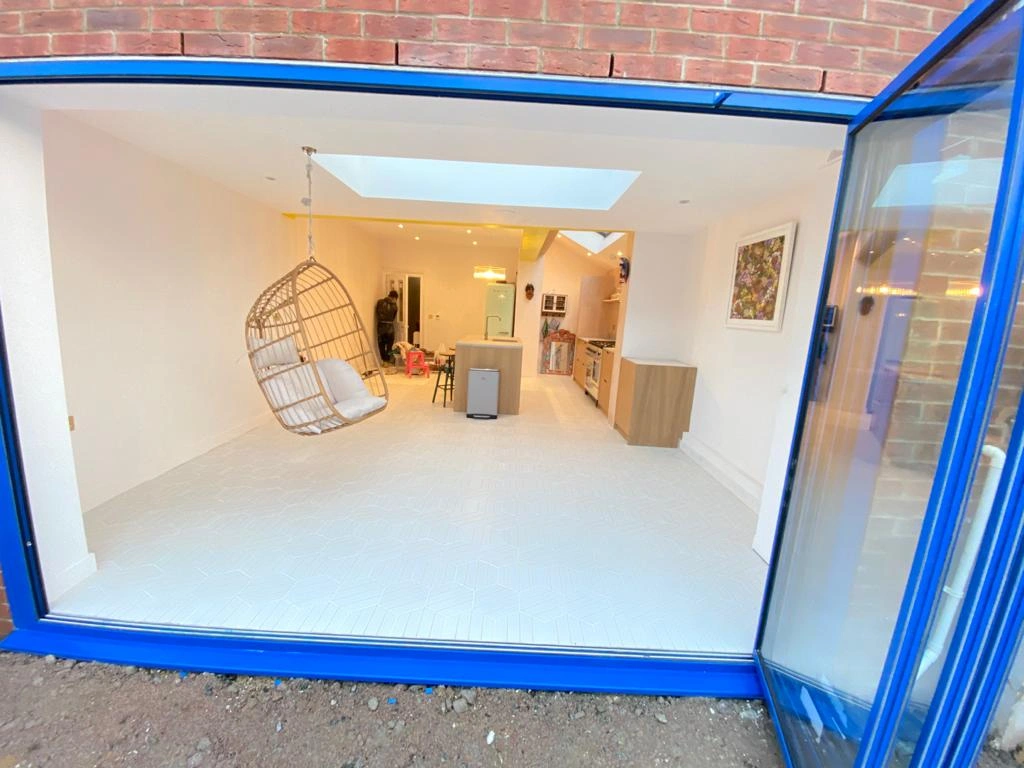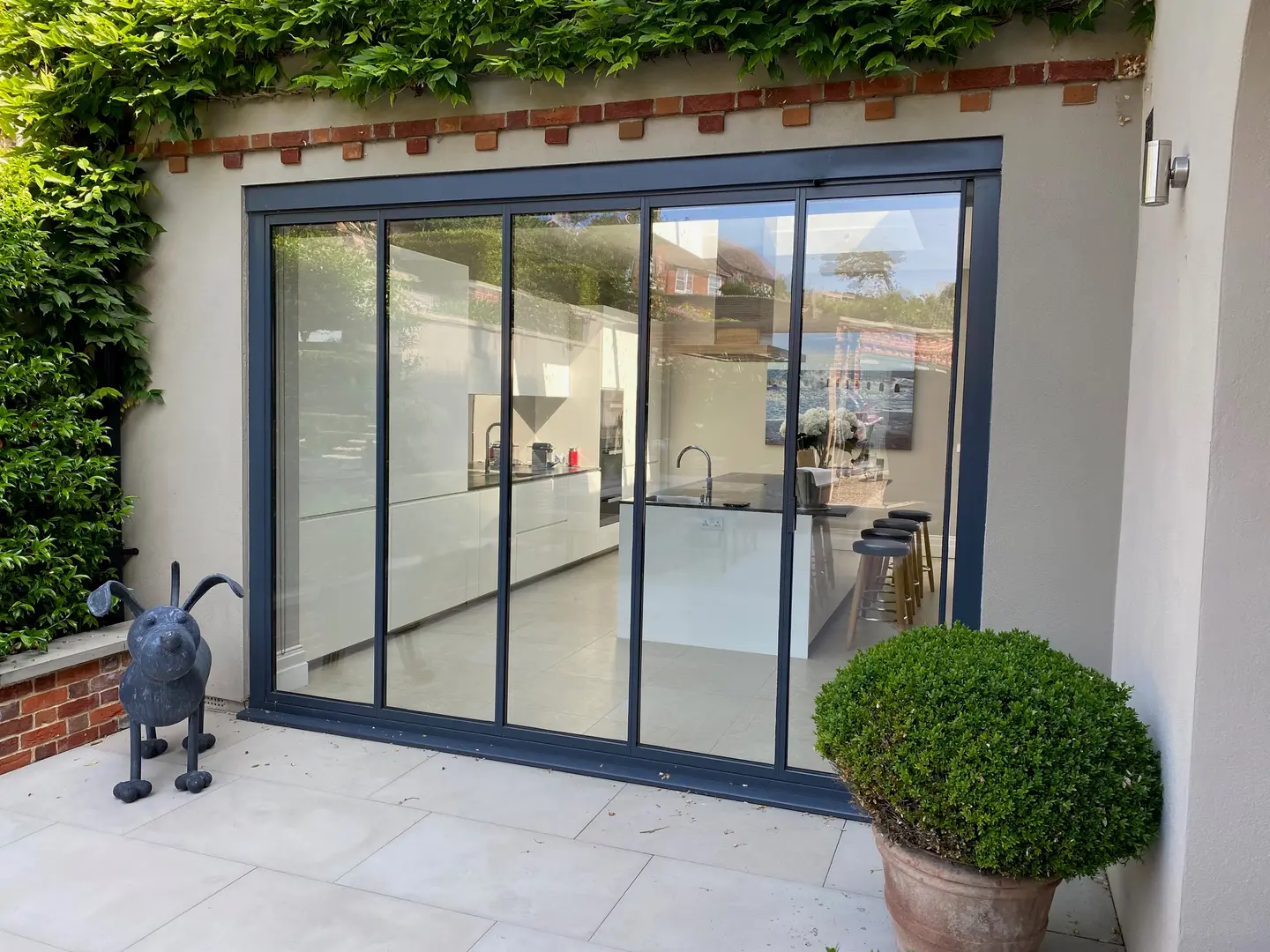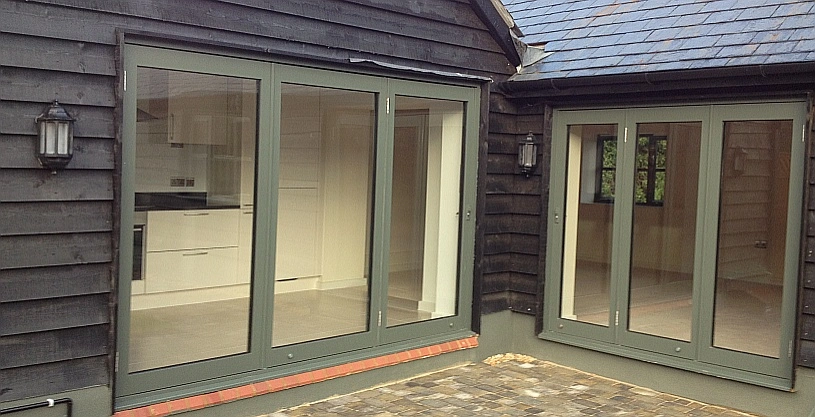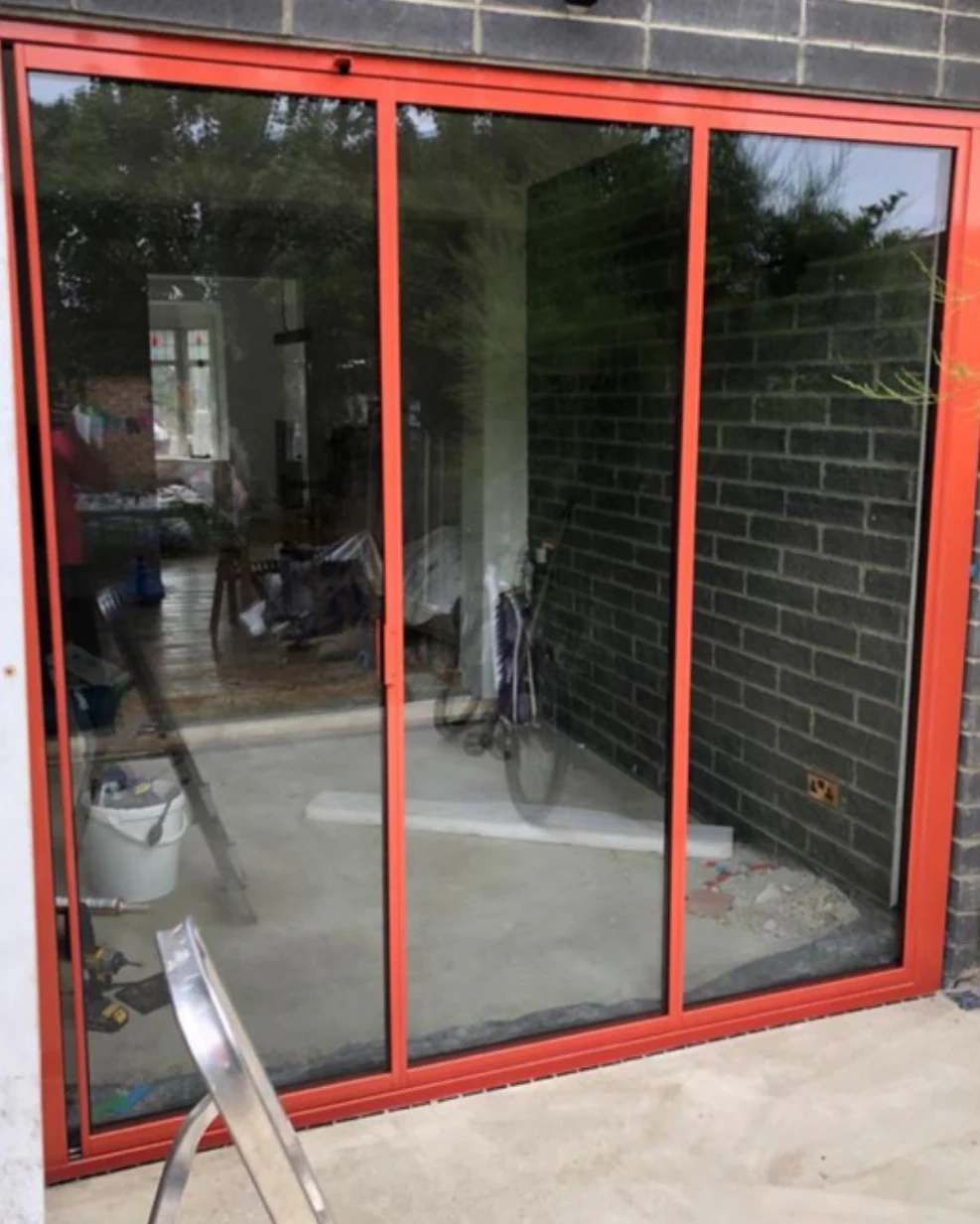Coloured Bifold Doors: Style and Selection Guide
Table of Contents

Introduction to Coloured Bifold Doors
Coloured bifold doors have moved far beyond basic white frames, with manufacturers now offering a wide variety of shades to match any home style. The right colour choice shapes how your bi-fold doors blend with both internal and external features, while poor colour selection can make even the highest quality doors look out of place.
Choosing Your Perfect Shade
Black framed doors remain a firm favourite among British homeowners, particularly in contemporary extensions where their bold lines create striking garden views. Moving away from monochrome, green bifold doors have gained momentum recently, with sage and olive tones bringing natural warmth to country properties and urban homes alike. Subtle cream and stone-coloured bifold doors work brilliantly in period properties, helping maintain character while adding modern functionality.

Making Colour Work for Your Space
Your room’s lighting plays a major part in how door colours appear throughout the day. North-facing rooms often benefit from lighter door frames that reflect available light, while south-facing spaces can handle darker popular shades without looking gloomy.
The surrounding wall colours, flooring, and furniture all influence your colour choices – what looks stunning in a showroom might clash with your existing décor.
Colour Psychology at Home
Door colours affect more than just appearances. Deep blues promote calm and focus, making them ideal for home offices or reading nooks. Warm greys create a neutral backdrop that won’t compete with bold furniture or artwork. Earthy browns help bring the outside in, especially when paired with natural materials like stone or wood flooring.
Expert Tip
Paint samples viewed in natural daylight give the most accurate representation of how coloured bifold doors will look in your space. Always check samples at different times of day and against your existing materials before making a final decision.
Today’s Most Popular Door Colours
Selecting from today’s bifold door colours requires careful thought about both current trends and lasting appeal. While fashions come and go, certain shades have proven their staying power across different architectural styles and property types.
Statement Colours That Work
Bold burgundy and forest green coloured bifold doors make powerful architectural statements without overwhelming your home’s exterior. These rich, deep tones work particularly well with red brick and natural stone, creating a sophisticated look that ages gracefully. Extra wide bifold doors in darker shades can appear less imposing when broken up into multiple panels, each one catching light differently as they fold.
Modern charcoal and slate tones remain firm favourites, especially in urban areas where sleek slim sightlines complement contemporary architecture. Dark frames tend to draw less attention to themselves, letting garden views take centre stage. A growing number of homeowners now opt for anthracite grey colour bifold doors, appreciating how this sophisticated shade suits both period properties and new builds.
Design Principles
Darker colours can make frames appear thinner, while lighter shades often emphasise the door structure. This optical effect helps when trying to achieve specific design goals – whether you want your doors to stand out as a feature or disappear into the background.

Subtle Neutrals and Greys
Neutral tones continue to dominate the market, with warm greys and soft beiges offering flexibility for future colour scheme changes. These understated options provide a modern touch without dating quickly. Cream and off-white coloured bifold doors remain popular in traditional homes, where they echo the appearance of painted timber without requiring the same maintenance.
Pale grey has emerged as a surprisingly adaptable choice, working equally well in minimalist urban homes and rustic country properties. Its subtle variations in different lights create interest without overwhelming other design elements. Light neutral frames often photograph better too – worth noting if you might sell your property in the future.
Dark vs Light Shades
The contrast between frame and wall colours affects how spacious a room feels. Dark coloured bifold doors against light walls create defined borders that can make spaces feel more intimate, while matching light frames to pale walls helps rooms flow smoothly into one another. This principle works both ways – light frames against dark walls can create striking features that draw attention to garden views.
Natural light levels should guide your choice between dark and light frames. North-facing rooms often benefit from lighter tones that reflect available light, while south-facing spaces can handle darker frames without feeling gloomy. Morning and evening sun brings out different qualities in metallic and textured finishes, something worth checking before making final decisions.
Some homeowners choose contrasting colours for internal and external faces of their doors – perhaps anthracite outside matching their windows, with softer shades inside fitting their interior style. This approach offers the best of both worlds, though it typically costs more than single-colour options.
Weather conditions also influence how different shades look throughout the year. Bright sunlight can wash out pale colours while making dark ones appear more intense. Coastal locations might see metallic finishes take on different characteristics as salt air creates subtle patinas over time. These environmental factors should inform colour choices just as much as style preferences.
Matching Colours to Your Home’s Style
Different property styles call for different approaches when choosing coloured bifold doors. While some homes suit bold statements, others need more subtle colour choices that respect their original character.
Period Properties
Victorian and Georgian homes often look best with coloured bifold doors that mirror traditional painted timber. Cream, soft grey, and sage green respect the original architecture while adding a fresh update. Some homeowners opt for dual colours on their bifold doors – perhaps darker shades outside matching original sash windows, with lighter internal faces complementing interior paintwork.
Dual colour options prove particularly valuable in listed buildings or conservation areas where planning officials may have specific requirements for external appearances. The flexibility to choose different internal and external finishes helps strike a balance between preservation and modern living. Many period property owners find that colour bifold doors in heritage shades receive easier planning approval than modern alternatives.
Heritage Colours
Traditional paint collections from major manufacturers often provide excellent inspiration for period-appropriate door colours. These carefully researched shades capture authentic historical tones while meeting modern performance standards.
Contemporary Homes
Modern properties can handle bolder colour choices. Jet black frames create dramatic contrasts with rendered walls, while metallic finishes catch light in interesting ways throughout the day. Bifold room dividers in striking colours have become a popular option for open-plan living spaces, defining different areas without blocking light or views.
Raw materials often guide colour selection in contemporary builds. Exposed concrete pairs beautifully with warm bronze or copper-toned coloured bifold doors, while timber cladding might call for contrasting darker shades. Industrial-style properties can pull off more unusual colour combinations, perhaps matching door frames to structural steel elements.

Country Cottages
Rural properties need careful colour selection to maintain their character. Coloured bifold doors in earthy tones like olive green or warm brown sit comfortably alongside natural stone and weathered timber. These softer shades help modern additions settle into traditional countryside settings.
Many cottage owners choose colour bifold doors that match their window frames for a coordinated look. This approach works particularly well with sage green, cream, or pale grey – colours that echo traditional country house paint schemes.
Natural light behaves differently in rural settings, often appearing warmer and softer than in urban areas, so colours might read differently than expected.
Surrounding landscapes should influence colour choices in country locations. Garden planting, neighbouring buildings, and local materials all play into creating a harmonious overall appearance. The changing seasons bring different qualities to various shades – some colours stand out beautifully against winter frost while others shine in summer sunshine.
Getting Creative with Colour
Adventurous homeowners can use coloured bifold doors to create striking visual effects. Modern manufacturing allows for precise colour matching and innovative finishes that go beyond standard paint options.
Two-Tone Designs
Mixing different coloured panels on bifold doors adds depth and visual interest to both interior and exterior views. Dark grey frames paired with lighter panels can make doors appear to float, while contrasting colours highlight architectural features. RAL colours offer almost unlimited possibilities for matching exact shades from other elements in your home.
Many homeowners now choose colour bifold doors with different shades on the frame and panels. This sophisticated approach works particularly well with textured paint finishes, which add subtle depth and help hide minor scratches or marks. The interplay of light on different surfaces creates ever-changing patterns as the sun moves throughout the day.
Colour Blocking
Popular colours for doors now include bold combinations that create striking geometric patterns. Blue bifold doors with contrasting panels can define spaces within open-plan layouts, while graduated colour schemes draw the eye through living areas. Some architects use colour blocking to highlight specific views or create focal points within a room.
Traditional colour theory principles still apply when experimenting with multiple shades. Complementary colours create bold statements, while analogous colour schemes offer more subtle variations. The size of your colour bifold doors should influence how adventurous you can be – larger installations might need more restraint to avoid overwhelming the space.
Hardware and Accessories
Handle colours and hinge finishes deserve careful thought when selecting colour bifold doors. Brushed metal hardware often works well with darker frames, while polished finishes can add sparkle to lighter shades. Some manufacturers offer custom-coloured hardware to match or contrast with door frames.
Thoughtfully chosen accessories can tie different elements together. A powder-coated letterbox in the same shade as your doors creates a cohesive look, while matching window frames helps establish visual rhythm across the building’s facade. Even small details like drain covers and external lights contribute to the overall effect.
Colour coordination extends beyond just the doors themselves. Many homeowners use their chosen door colours as starting points for wider design schemes. Interior wall colours might pick up subtle undertones from the frames, while external paintwork could complement or contrast with the main door colour. This holistic approach helps create spaces that feel carefully planned rather than randomly assembled.
Paint Types and Finishes for Coloured Bifold Doors
The longevity of coloured bifold doors depends heavily on the quality and type of finish applied. Different coating methods offer varying levels of durability, weather resistance, and surface appearance.

Powder Coating
Powder coating creates tough, long-lasting finishes that resist chipping and fading. This process involves electrostatically applying dry powder to metal frames, then baking it to form a hard shell. Modern colour bifold doors typically use powder coating because it produces consistent results and holds up well against British weather.
Light colours need extra care during the powder coating process to achieve even coverage. Multiple layers might be necessary for perfect opacity, particularly on whites and pale greys. The powder coating technique allows for subtle variations in texture, from completely smooth surfaces to slightly stippled finishes that help hide minor marks.
Quality powder coating should meet specific industry standards for thickness, adhesion, and UV resistance. These standards help ensure your doors maintain their appearance over many years.
Textured vs Smooth
Textured finishes on coloured bifold doors offer practical benefits beyond pure aesthetics. Fine textures help disguise small scratches and fingerprints, making them ideal for busy family homes. Smooth finishes provide a more contemporary look but typically show wear more readily.
The manufacturing process for colour bifold doors allows for various texture depths. Some homeowners prefer subtle, almost leather-like finishes that add character without being immediately obvious. Others choose more pronounced textures that create interesting shadow patterns as light moves across the surface.
Coastal Environments
Properties near the sea need specially formulated finishes to withstand salt spray and intense UV exposure. Marine-grade powder coating provides extra protection for colour bifold doors in coastal locations. These specialised coatings include additional protective layers that resist corrosion and maintain colour stability despite harsh conditions.
Salt air can quickly damage inferior finishes, leading to bubbling or peeling. Professional installers working in coastal areas should automatically recommend appropriate marine-grade options. While these finishes cost more initially, they prove more economical over time by avoiding premature replacement or refinishing.
The intense sunlight in coastal areas affects how different paint colours appear. Dark coloured bifold doors might fade more quickly in these conditions, while certain light-coloured finishes can appear dazzling on bright days. South-facing installations particularly need high-quality UV-resistant coatings to maintain their appearance.
Real-World Colour Combinations
Smart colour pairings help coloured bifold doors work harmoniously with your home’s existing features. From kitchen extension bifold doors to living room installations, each space presents unique colour challenges.
Interior Colours
Wall colours strongly shape how your doors look from inside. Bright whites can make brown bifold doors appear darker and more dramatic, while cream walls soften their impact. Green bifold doors take on different characters against various backdrops – appearing more grey against warm neutrals, or more vibrant against cool whites.
Paint companies now offer specific colour palettes designed to work with different door finishes. These carefully curated combinations take the guesswork out of matching your colour bifold doors to interior schemes. Many professional designers start with the door colour as a foundation, then build complementary wall and floor colours around it.
Lighting Changes
Natural and artificial lighting alter how colours appear throughout the day. Morning sun might bring out warm undertones in metallic finishes, while evening light can make blue bifold doors appear almost black. Testing paint samples under different lighting conditions helps avoid surprises after installation.
External Features
Tall bifold doors need particularly thoughtful colour selection, as they dominate exterior views. Brick colour, roof tiles, and surrounding windows all influence which door colours work best. Some homeowners match their doors to existing window frames for continuity, while others use contrasting shades to create focal points.
Garden planting can impact exterior colour choices too. Dark doors might disappear against dense evergreen hedges, while lighter frames stand out beautifully. Seasonal changes in garden colours can make door colours appear different throughout the year – something worth remembering when browsing colour charts in the showroom.
The neighbourhood context matters when selecting external door colours. While modern developments often welcome bold colour choices, conservation areas might restrict options. Some streets have unwritten colour conventions that help maintain visual harmony – worth noting before ordering bright orange colour bifold doors for a street lined with subtle greys.
Clever colour placement can improve your home’s proportions. Darker shades might help tall doors appear less imposing, while lighter colours can make modest openings feel more generous. Architects often use door colours strategically to draw attention toward or away from specific features.
Sunlight exposure varies greatly between north and south-facing installations. South-facing coloured bifold doors receive intense sunlight that can make bold colours appear even brighter, while north-facing installations might need lighter shades to compensate for lower light levels. East and west-facing doors experience dramatic lighting changes throughout the day, something to factor into colour decisions.
External materials beyond just walls need thought. Paving colours, garden furniture, and even neighbouring properties all contribute to how your door colour reads from outside. Taking photos of these elements to the showroom helps make more informed colour choices. Some manufacturers now offer visualisation tools that show how different door colours look in various settings.
Maintaining Your Coloured Doors
Regular maintenance keeps coloured bifold doors looking fresh for years while protecting their finish from wear and environmental damage. Different colours and finishes need specific care routines to maintain their appearance.
Cleaning Different Finishes
Powder-coated coloured bifold doors need gentle cleaning with warm, soapy water and a soft cloth. Harsh chemicals or abrasive cleaners can damage the finish, leading to premature aging or colour fading. White and pale colour bifold doors might need more frequent cleaning to stay bright, while darker shades often hide dust and marks between cleaning sessions.
Textured surfaces require special attention during cleaning. Dirt can settle into the texture pattern, requiring a soft brush to remove effectively. Some manufacturers provide specific cleaning products designed for their finishes – these often contain protective elements that help maintain the original appearance.
Professional maintenance once or twice yearly helps spot potential issues before they become serious. This routine checking proves particularly important for colour bifold doors in coastal areas or other challenging environments.
Touch-Ups and Repairs
Minor scratches in colour bifold doors need quick attention to prevent corrosion underneath the coating. Touch-up paint must exactly match the original finish – many suppliers provide small paint pots for this purpose. Deep scratches or dents might need professional repair to maintain weather resistance and appearance.
Paint touch-ups work best in warm, dry conditions. Cold or damp weather affects how repair paints cure, potentially leading to visible differences in finish. Some colours prove harder to match than others – metallics and pearlescent finishes often need specialist repair techniques to achieve invisible fixes.
Weather Impact
Sun exposure gradually changes how painted surfaces look over time. South-facing installations see the most intense UV exposure, which can cause subtle colour shifts in some finishes. High-quality powder coating includes UV protection that helps maintain colour stability, though no finish remains completely immune to sun damage.
Seasonal temperature changes make metal expand and contract, putting stress on paint finishes. Quality coloured bifold doors use materials and coating methods designed to handle these natural movements without cracking or peeling. Rain, frost, and varying humidity levels test door finishes throughout the year – proper maintenance helps them withstand these challenges.
Different climates pose unique challenges for door finishes. Coastal properties face salt spray and strong winds, while urban locations might deal with industrial pollution. Understanding your local conditions helps choose appropriate cleaning schedules and maintenance products. Some environments might need more frequent professional checks to ensure finishes stay protected.
Touch-up kits and repair services from original manufacturers offer the best chance of matching existing colours exactly. Generic repair products rarely achieve perfect matches, especially with metallic or specialist finishes. Keeping records of your door’s exact colour specification helps when ordering touch-up materials or arranging repairs.
We’d Love to Help You
Vision Glass Doors is a designer, manufacturer, and installer of premium door systems. We are a family run business with over 20 years’ experience and 5,000 installations across the UK.
Our leading range of door systems include Ultra Slim – Slide and Turn Doors, Slimline Sliding Patio Doors and Frameless Glass Doors. Suitable for various internal and external applications, they are applicable to residential and commercial projects.
Click Quick Quote Online for a free quotation within 24 hours. Alternatively, call or email us on 01582 492730 or at info@visionglassdoors.co.uk.

